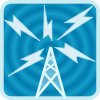- Communications in the United States
-
The primary regulator of communications in the United States is the Federal Communications Commission. It closely regulates all of the industries mentioned below with the exception of newspapers and the Internet service provider industry.
Contents
History
Press
Main article: Newspapers in the United StatesNewspapers declined in their influence and penetration into American households in the late 20th century. Most newspapers are local, having little circulation outside their particular metropolitan area. The closest thing to a national paper the U.S. has is USA Today. Other influential dailies include the New York Times, the Washington Post and the Wall Street Journal which are sold in most U.S. cities. The Times has a moderate-left stance, while the Journal is moderate-right and is strongly pro-business.
The largest newspapers (by circulation) in the United States are USA Today, the Wall Street Journal, the New York Times and the Los Angeles Times.
Mail
The legal monopoly of the government-owned United States Postal Service has narrowed during the 20th and 21st centuries, although the USPS, through whose hands passes 40% of the world's mail,[citation needed] still delivers more mail in four days than is delivered by DHL Express, FedEx, and the United Parcel Service in one year.[citation needed]
Telephone
Telephone system:
General assessment: A large, technologically advanced, multipurpose communications system.
Domestic: A large system of fiber-optic cable, microwave radio relay, coaxial cable, and domestic satellites carries every form of telephone traffic; a rapidly growing cellular system carries mobile telephone traffic throughout the country.
International: Country code - 1; 24 ocean cable systems in use; satellite earth stations - 61 Intelsat (45 Atlantic Ocean and 16 Pacific Ocean), 5 Intersputnik (Atlantic Ocean region), and 4 Inmarsat (Pacific and Atlantic Ocean regions) (2000).Landlines
Telephones - main lines in use: 141 million (2009)[1]
- Most of the American telephone system was formerly operated by a single monopoly, AT&T, which was split up in 1984 into a long distance telephone company and several local "Baby Bells."
- Landline telephone service continues to be divided between incumbent local exchange carriers and several competing long distance companies. As of 2005, some of the Baby Bells are beginning to merge with long distance phone companies. A small number of consumers are currently experimenting with Voice over Internet Protocol phone service.
- Most local loop service to homes is provided through old-fashioned copper wire, although many of the Baby Bells are beginning to upgrade the so-called "last mile" to fiber optic.
- Early in the 21st century the number of wire lines in use stopped growing and in some markets began to decline.[2]
Cellular communication
Main article: Mobile phone industry in the United StatesTelephones - mobile cellular: 286 million (2009)[1]
- Most states have several competing cellular phone networks.
- The major cellphone companies in the U.S. are AT&T Mobility, Verizon Wireless, Sprint Nextel, and T-Mobile
Radio
Main article: Radio in the United StatesRadio broadcast stations: AM: 4,789; FM commercial stations: 6,231; FM educational stations: 2,672; FM translators & boosters: 3,995; low-power FM stations: 675 (as of December 31, 2005, according to the Federal Communications Commission)
- Most broadcast stations are controlled by large media conglomerates like Clear Channel Communications. There are also many small independent local stations. National Public Radio (NPR) is the public radio network.
Radios: 575 million (1997)
Television
Main article: Television in the United StatesTelevision broadcast stations: 9,024 (of which 1,750 are full-power TV stations; 592 are class-A TV stations; 4,537 are TV translators; and 2,145 are other low-power TV stations) (as of December 31, 2005, according to the Federal Communications Commission); in addition, there are about 12,000 cable TV systems.
- Most local commercial television stations are owned-and-operated by or affiliated with the large national broadcast networks such as ABC, CBS, Fox, NBC, and The CW. Some television networks are aimed at ethnic minorities, including Spanish language networks Univisión and Telemundo. Public Broadcasting Service (PBS), is the public broadcasting network, with over 300 non-profit affiliated stations across the United States. Besides the large broadcast networks (which are free for anyone with a TV and an antenna), there are also many networks available only with a subscription to cable or satellite television, like CNN.
Televisions: 219 million (1997)
See also: List of United States broadcast television networks and List of United States cable and satellite television networksInternet
Main article: Internet in the United StatesInternet Service Providers (ISPs): 7,600 (1999 est.)
- Because of aggressive lobbying and the United States' strong libertarian traditions, the Internet service provider industry remains relatively unregulated in comparison to other communications industries.
Country code (Top level domain): US
- For various historical reasons, the .us domain was never widely used outside of a small number of government agencies and school districts. Most companies signed up for top level domains like .com instead.
- NeuStar Inc. now has control over the .us registry and is trying to promote the domain as an option for American-oriented Web sites.
See also
- United States of America
- Media in the United States
- Mobile phone industry in the United States
- Cable television in the United States
- National broadband plans from around the world
References
Communications in North America Sovereign states Dependencies and
other territories- Anguilla
- Aruba
- Bermuda
- Bonaire
- British Virgin Islands
- Cayman Islands
- Curaçao
- Greenland
- Guadeloupe
- Martinique
- Montserrat
- Navassa Island
- Puerto Rico
- Saint Barthélemy
- Saint Martin
- Saint Pierre and Miquelon
- Saba
- Sint Eustatius
- Sint Maarten
- Turks and Caicos Islands
- United States Virgin Islands
Telecommunications (general) History - Beacons
- Broadcasting
- Computer networks
- Drums
- Electrical telegraphy
- Fax
- Heliography
- Hydraulic telegraphs
- Internet
- Mass media
- Mobile phones
- Optical telegraphy
- Photophone
- Radio
- Radiotelephone
- Satellite communications
- Telegraphy
- Telephones
- Telephone patent controversies
- Television
- Undersea telegraph lines
- Videophones

Pioneers Mediums - Coaxial cable
- Free-space optical
- Landlines
- Optical fiber
- Radio waves
- Terrestrial microwave
Networks Geographic Telecommunications in Europe Sovereign
states- Albania
- Andorra
- Armenia
- Austria
- Azerbaijan
- Belarus
- Belgium
- Bosnia and Herzegovina
- Bulgaria
- Croatia
- Cyprus
- Czech Republic
- Denmark
- Estonia
- Finland
- France
- Georgia
- Germany
- Greece
- Hungary
- Iceland
- Ireland
- Italy
- Kazakhstan
- Latvia
- Liechtenstein
- Lithuania
- Luxembourg
- Macedonia
- Malta
- Moldova
- Monaco
- Montenegro
- Netherlands
- Norway
- Poland
- Portugal
- Romania
- Russia
- San Marino
- Serbia
- Slovakia
- Slovenia
- Spain
- Sweden
- Switzerland
- Turkey
- Ukraine
- United Kingdom
- (England
- Northern Ireland
- Scotland
- Wales)
States with limited
recognition- Abkhazia
- Kosovo
- Nagorno-Karabakh
- Northern Cyprus
- South Ossetia
- Transnistria
Dependencies
and other territories- Åland
- Faroe Islands
- Gibraltar
- Guernsey
- Jan Mayen
- Jersey
- Isle of Man
- Svalbard
Other entities Telecommunications in North America Sovereign states Dependencies and
other territories- Anguilla
- Aruba
- Bermuda
- Bonaire
- British Virgin Islands
- Cayman Islands
- Curaçao
- Greenland
- Guadeloupe
- Martinique
- Montserrat
- Navassa Island
- Puerto Rico
- Saint Barthélemy
- Saint Martin
- Saint Pierre and Miquelon
- Saba
- Sint Eustatius
- Sint Maarten
- Turks and Caicos Islands
- United States Virgin Islands
Telecommunications in South America Sovereign states Dependencies and
other territoriesTelecommunications in Oceania Sovereign states - Australia
- East Timor (Timor-Leste)
- Fiji
- Indonesia
- Kiribati
- Marshall Islands
- Federated States of Micronesia
- Nauru
- New Zealand
- Palau
- Papua New Guinea
- Samoa
- Solomon Islands
- Tonga
- Tuvalu
- Vanuatu
Dependencies and
other territories- American Samoa
- Christmas Island
- Cocos (Keeling) Islands
- Cook Islands
- Easter Island
- French Polynesia
- Guam
- Hawaii
- New Caledonia
- Niue
- Norfolk Island
- Northern Mariana Islands
- Pitcairn Islands
- Tokelau
- Wallis and Futuna
Telecommunications in Africa Sovereign
states- Algeria
- Angola
- Benin
- Botswana
- Burkina Faso
- Burundi
- Cameroon
- Cape Verde
- Central African Republic
- Chad
- Comoros
- Democratic Republic of the Congo
- Republic of the Congo
- Côte d'Ivoire (Ivory Coast)
- Djibouti
- Egypt
- Equatorial Guinea
- Eritrea
- Ethiopia
- Gabon
- The Gambia
- Ghana
- Guinea
- Guinea-Bissau
- Kenya
- Lesotho
- Liberia
- Libya
- Madagascar
- Malawi
- Mali
- Mauritania
- Mauritius
- Morocco
- Mozambique
- Namibia
- Niger
- Nigeria
- Rwanda
- São Tomé and Príncipe
- Senegal
- Seychelles
- Sierra Leone
- Somalia
- South Africa
- South Sudan
- Sudan
- Swaziland
- Tanzania
- Togo
- Tunisia
- Uganda
- Zambia
- Zimbabwe
States with limited
recognition- Sahrawi Arab Democratic Republic
- Somaliland
Dependencies and
other territories- Canary Islands / Ceuta / Melilla / Plazas de soberanía (Spain)
- Madeira (Portugal)
- Mayotte / Réunion (France)
- Saint Helena / Ascension Island / Tristan da Cunha (United Kingdom)
- Western Sahara
Telecommunications in Asia Sovereign
states- Afghanistan
- Armenia
- Azerbaijan
- Bahrain
- Bangladesh
- Bhutan
- Brunei
- Burma (Myanmar)
- Cambodia
- People's Republic of China
- Cyprus
- East Timor (Timor-Leste)
- Egypt
- Georgia
- India
- Indonesia
- Iran
- Iraq
- Israel
- Japan
- Jordan
- Kazakhstan
- North Korea
- South Korea
- Kuwait
- Kyrgyzstan
- Laos
- Lebanon
- Malaysia
- Maldives
- Mongolia
- Nepal
- Oman
- Pakistan
- Philippines
- Qatar
- Russia
- Saudi Arabia
- Singapore
- Sri Lanka
- Syria
- Tajikistan
- Thailand
- Turkey
- Turkmenistan
- United Arab Emirates
- Uzbekistan
- Vietnam
- Yemen
States with limited
recognition- Abkhazia
- Nagorno-Karabakh
- Northern Cyprus
- Palestine
- Republic of China (Taiwan)
- South Ossetia
Dependencies and
other territories- Christmas Island
- Cocos (Keeling) Islands
- Hong Kong
- Macau
Categories:
Wikimedia Foundation. 2010.


